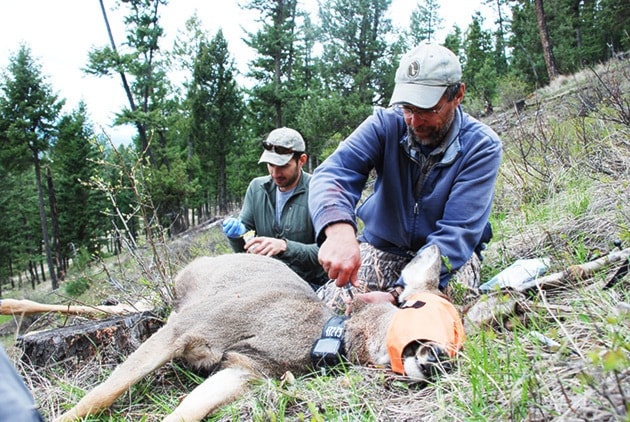Due to a significant decline in mule deer populations, provincial biologists are keeping an eye on mortality and migration patterns through an ongoing mule deer monitoring project in the Kootenay region.
The project includes a pilot translocation study that moved 20 deer out of four East Kootenay communities, including Cranbrook, into more remote wintering ranges.
As part of the Upper Kootenay Enhancement Plan, a partnership between the Fish and Wildlife Compensation Program and the Columbia Basin Trust, biologists have been tracking 88 female mule deer fitted with GPS collars in the Wigwam/Grasmere, Newgate, Dutch-Findlay and West Kootenay areas.
Biologists are finding that different populations are exhibiting very distinct migration patterns. Mule deer on the east side of Koocanusa Reservoir are moving great distances, typically up to 60 kilometres, and even into Alberta and back.
“This is probably related to quality of habitat,” said project lead and FLNRO wildlife biologist, Patrick Stent. “The deer on the east side have access to a lot of highly productive summer range habitat, including regenerating burns and sub-alpine terrain, and will use it, while those on the west side are limited to a rolling, low elevation forested landscape and are more restricted. It did surprise us that the Grasmere/Wigwam deer were crossing multiple big drainages to spend their summer in specific sites.”
The study is in the second year of a five year term.
Since beginning last year, there have been 19 mule deer mortalities, mostly due to predation. According to Stent, seven were killed by cougars, five by wolves, and one by an unknown predator. Three deer were killed by vehicle collisions, one by illegal poaching, one by natural causes, and one with an unknown cause of death.
“These causes of mortality are not surprising and survival rates are within the ranges reported in other Mule Deer populations in the northwest US,” Stent said. “It is possible that the project started after the population decline occurred and mule deer populations may just now be recovering. We hope to continue the project over the long-term so we can gain a better understanding of factors that contribute to declines when they occur.”
The project, through models, suggests that there could be modest population growth in mule deer herds east and west of Koocanusa Reservoir due to a high number of fawns being produced and two mild winters.
There isn't enough data from other herds to report any initial findings.
Stent also adds that there has been some valuable data gathered from the deer translocated out of some East Kootenay communities, including Cranbrook and Kimberley, under a trial program headed up by Adams and Vast Resource Solutions.
"And finally there is a positive spin-off of doing this work right now because of the pilot project currently being implemented to relocate Mule Deer from some urban areas to areas where resident populations have declined,” said Stent. “We can directly compare survival rates and movement between those collared urban deer released into our study area, and those deer we have collared."
In the pilot project, 60 deer were moved out of Cranbrook, Kimberley, Invermere and Elkford. Of those ungulates, 29 were fitted with GPS collars, and eight have since died, mostly from cougar predation.
“That’s just over 25 per cent mortality which is better than many people thought the urban deer would suffer,” said Adams of VAST Resource Solutions, who is the project coordinator. “The big surprise is that their movements have varied considerably – some moving over 300 kilometres, and others have stayed very close to their release site.”
The two projects are unique in that it's giving biologists a chance to collect data on both urban and non-urban deer. With both radio-collared non-urban and urban deer, biologists are using the non-urban deer as a control population to collect movement and survival data on translocated urban deer. For the non-urban deer, more ungulates will be collared later this year in the West Kootenays.
The Fish & Wildlife Compensation Program is a partnership between BC Hydro, the Province of B.C., Fisheries and Oceans Canada, First Nations and Public Stakeholders to conserve and enhance fish and wildlife impacted by BC Hydro dams. For more about this Mule Deer project, and other projects being funded by the FWCP, visit fwcp.ca.
